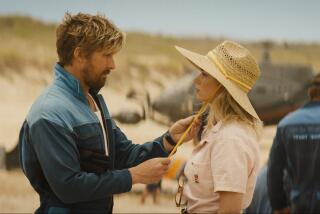Leigh Evokes ‘Topsy-Turvy’ Age of Gilbert and Sullivan
A Mike Leigh musical? With costumes? In period? Is this the world turned upside down for this remarkable British writer-director, whose films “Life Is Sweet,” “Naked,” and “Secrets & Lies” raised the bar for the level of gritty honesty and emotional sensitivity we can expect from contemporary dramas?
Actually, though it looks like “Gone With the Wind” compared to his earlier work, “Topsy-Turvy” is very much a Leigh project, one he’s had on his mind for some time. Its setting is the theater (Leigh’s original home), and fittingly for a man who pioneered a different way of making films, its focus is on the mysterious intricacies of the creative process.
Not just anyone’s process, but that of London-based William Schwenck Gilbert and Arthur Sullivan, the extraordinary duo who turned British light opera into something like a religion with fiendishly clever productions such as “H.M.S. Pinafore” and “The Pirates of Penzance.” “Topsy-Turvy” is filled with their music and follows the pair during a pivotal year in their lives, from the premiere of 1884’s “Princess Ida” through a near-fatal impasse that ended in one of their greatest triumphs, “The Mikado.”
One reason it took several years to put this production together is that Leigh, believer in authenticity that he is, wouldn’t proceed unless he had the budget to reproduce the period in all its sumptuous glory. Working with production designer Eve Stewart, costumer Lindy Hemming and cinematographer Dick Pope, he’s brought superlative production values to bear on what is essentially a backstage story.
Leigh’s singular method of working, the way he involves the actors in creating their characters from the ground up via months of intense preparation, serves him well even in period drama. The performances cut deeper than usual for costume films, and the actors once again seem to literally become who they’re playing. That’s especially true with the intense, captivating work done by Allan Corduner as Sullivan and Leigh veteran Jim Broadbent as Gilbert, a team as oddly but perfectly matched as Laurel and Hardy.
It’s Sullivan we meet first, rousing himself from a sickbed to conduct his music for “Princess Ida.” A sybarite who enjoys life’s pleasures, very much including his American mistress Mrs. Fanny Ronalds (Eleanor David), Sullivan is often so satisfied with what life has placed before him he positively twinkles.
But if the composer is someone who relished the best, lyricist Gilbert is a grump’s grump who, despite the efforts of cheerful wife Kitty (Lesley Manville), always expects the worst. He fumes over the indifferent reviews “Princess Ida” gets, and fumes even more when he’s referred to as “the king of topsy-turvydom” because of his string of farfetched plots.
Despite their differences, Gilbert and Sullivan treat each other with exquisite “there’ll always be an England” deference when they’re in the same room. But under that polished surface, tensions exist, for each man feels like he has subordinated his own superior talents for the good of the partnership.
Those papered-over conflicts erupt when Sullivan, who has designs on writing serious music, announces to impresario Richard D’Oyly Carte (Ron Cook, who was vivid as the bitter ex-photography partner in “Secrets & Lies”) that he will write no more for him. “I cannot,” he says sadly, “waste any more time on these souffles.”
Since G&S; owe Carte one more opera, Gilbert comes up with another topsy-turvy plot, but Sullivan dismisses it by saying he refuses to be “treated like a barrel organ: Turn the handle and out pops a tune.”
Then, as it does in real life as well as the movies, chance takes a turn. Entranced by three tiny Japanese ladies she spies on the street, Kitty drags Gilbert, much against his will, to a Japanese exhibition on display in London. His imagination fired, Gilbert puts on his thinking cap (he really has one), and the ideas for “The Mikado” start to percolate.
Much of “Topsy-Turvy” deals with the fascinating ways Gilbert and Sullivan deal with each other (“working with Gilbert could kill anyone,” a witness truly says), and how Gilbert, a prototype for the modern stage director, sorts through all the problems and personalities that go into putting on a new theatrical production.
For though Gilbert and Sullivan are the marquee attractions, attention is also paid, in “Upstairs, Downstairs” style, to the little people, the cast members who are trying to put on a cross-cultural production before it was even a word. Especially strong is Leigh veteran Timothy Spall in playing leading actor Richard Temple, whose creative process in taking on the role of the Mikado has more bumps than he anticipated.
At two hours and 41 minutes, “Topsy-Turvy” is a bit longer than it might be, a bit more attached to its digressions than we might wish. But the length does encourage the feeling that we’ve been through the whole creative process with Gilbert and Sullivan and their cast, which makes our applause and enthusiasm when things turn out right in the end that much more heartfelt.
* MPAA rating: R, for a scene of risque nudity. Times guidelines: The scene, set in a French brothel, is silly rather than erotic.
(BEGIN TEXT OF INFOBOX / INFOGRAPHIC)
‘Topsy-Turvy’
Jim Broadbent: William Schwenck Gilbert
Allan Corduner: Arthur Sullivan
Timothy Spall: Richard Temple
Lesley Manville: Lucy “Kitty” Gilbert
Ron Cook: Richard D’Oyly Carte
Wendy Nottingham: Helen Lenoir
October Films presents a Simon Channing-Williams production, in association with Thin Man Films Limited/The Greenlight Fund/Newmarket Capital Group, released by USA Films. Director Mike Leigh. Producer Simon Channing-Williams. Screenplay Mike Leigh. Cinematographer Dick Pope. Editor Robin Sales. Costumes Lindy Hemming. Music from Arthur Sullivan, Carl Davis. Production design Eve Stewart. Art director Helen Scott. Set decorators Eve Stewart, John Bush. Running time: 2 hours, 41 minutes.
In limited release.
More to Read
Only good movies
Get the Indie Focus newsletter, Mark Olsen's weekly guide to the world of cinema.
You may occasionally receive promotional content from the Los Angeles Times.











